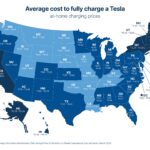Is the iconic 5.0L Coyote V8 engine in the Ford F-150 a gas-guzzling relic of the past, especially when navigating the stop-and-go of city commuting? Or can this naturally aspirated powerhouse hold its own in an era of turbochargers and hybrid technology? We put the Ford F-150 5.0 to the test in the urban jungle to find out.
Earlier this year, we explored the fuel efficiency of the Ford F-150 PowerBoost hybrid, and were impressed by its blend of power and economy. But for many truck enthusiasts, nothing quite replaces the rumble and responsiveness of a V8. That’s where the 5.0L Coyote comes in. We spent a week behind the wheel of a 2024 Ford F-150 Tremor, equipped with the legendary 5.0L V8, to assess its real-world city fuel consumption. Forget manufacturer claims and EPA estimates – we wanted to know what you can actually expect when daily driving in a demanding urban environment.
The Ford 5.0L Coyote V8: A Legacy of Truck Performance
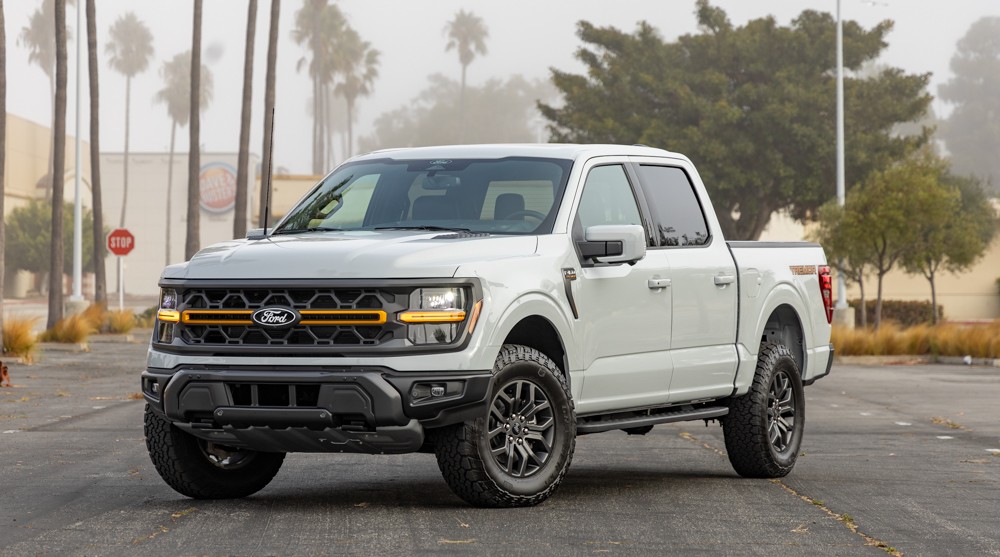 2024 Ford F-150 Tremor, powered by a 5.0L Coyote V8
2024 Ford F-150 Tremor, powered by a 5.0L Coyote V8
The 5.0L Coyote V8 is more than just an engine; it’s a cornerstone of Ford’s performance heritage. Introduced in 2011 for both the Mustang and F-150, the Coyote quickly established itself as a modern marvel, blending high-revving horsepower with robust truck-ready torque. Unlike Ford’s turbocharged EcoBoost engines, the naturally aspirated Coyote delivers power in a linear, predictable fashion, accompanied by the unmistakable V8 soundtrack that enthusiasts crave.
In its current fourth generation, the 5.0L Coyote in the 2024 Ford F-150 boasts impressive specifications. This 307 cubic inch (5.038L) engine features a high 12:1 compression ratio and utilizes both port and direct fuel injection for optimized performance and efficiency. It churns out a healthy 400 horsepower at 6,000 RPM and 410 lb.-ft. of torque at 4,250 RPM. To further enhance fuel economy, the 2024 models include a stop/start system, which can be deactivated if desired. While Mustang versions of the Coyote prioritize high-end horsepower, the F-150 variant is tuned for strong mid-range torque, perfectly suited for truck duties and everyday driving.
City Commuting with the 5.0L Coyote: Our Real-World MPG Experience
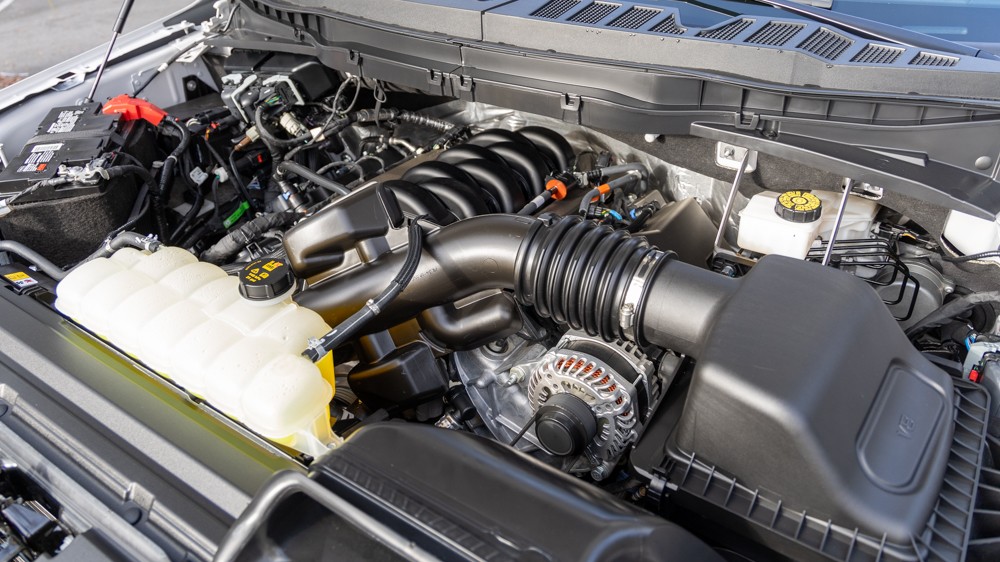 2024 Ford F-150 5.0L Coyote V8 engine showcasing its dual overhead cam design
2024 Ford F-150 5.0L Coyote V8 engine showcasing its dual overhead cam design
To gauge the city fuel economy of the Ford F-150 5.0L V8, we subjected our Tremor test truck to a week of typical Los Angeles commuting. This included daily school runs, errands, and navigating the notorious LA traffic. Our test route was a mix of stop-and-go city streets, frequent stoplights, school pickup lines, and occasional short freeway stretches – a true representation of urban driving.
Our driving routine was designed to mirror real-world scenarios. We drove approximately 15 miles round trip for school commutes, encountering heavy traffic and idling in pickup lines. We also included trips to our office, grocery runs, and various errands, accumulating a total of 181.7 miles during the test period. And yes, we admit to a few spirited accelerations to enjoy the Coyote’s signature V8 growl – purely for research purposes, of course!
The result? Over 181.7 miles of mixed city driving, the Ford F-150 Tremor 5.0L V8 averaged 11.1 mpg according to the truck’s computer.
Interestingly, the fuel economy remained remarkably consistent throughout our test. Initial readings were around 10.9 mpg, gradually climbing to a peak of 11.7 mpg before settling at a steady 11.1 mpg. This consistency suggests that in demanding city driving conditions, the 5.0L Coyote V8 will likely deliver fuel economy in the low 11 mpg range. While this might not win any fuel efficiency awards, it’s crucial to consider the context: we were driving a full-size, off-road-oriented truck in one of the most congested cities in the world.
5.0L Coyote vs. PowerBoost Hybrid: The City MPG Battle
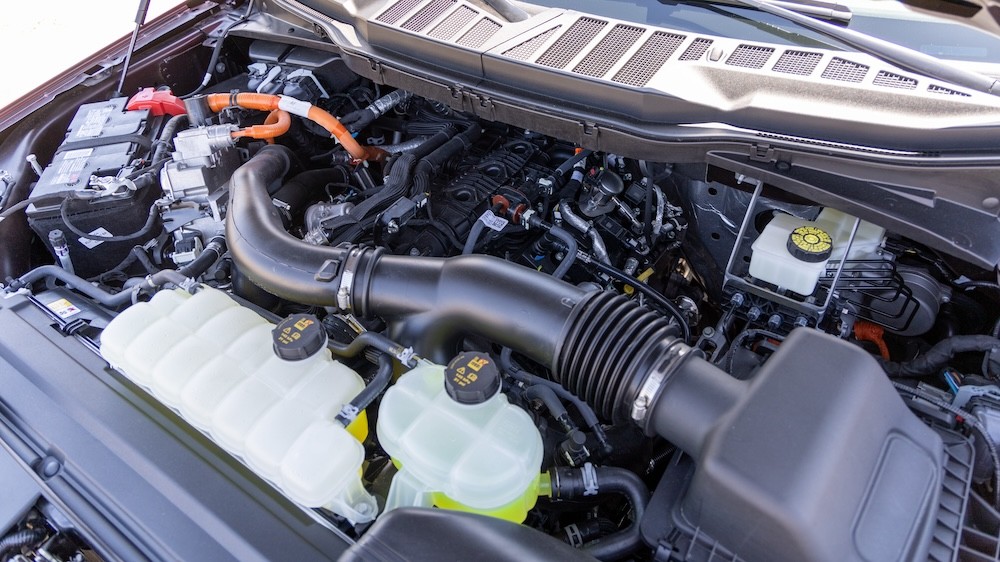 Ford 3.5L PowerBoost V6 Hybrid engine, highlighting its electric motor integration
Ford 3.5L PowerBoost V6 Hybrid engine, highlighting its electric motor integration
How does the 5.0L Coyote V8 compare to Ford’s advanced 3.5L PowerBoost hybrid in city driving? In our previous test, the PowerBoost demonstrated significantly better fuel economy, especially in urban environments, achieving around 15-20 mpg in similar LA city conditions.
The PowerBoost’s advantage stems from its electric motor assist and ability to operate in electric-only mode at lower speeds, particularly beneficial in stop-and-go traffic. The hybrid system shines when the gasoline engine is cold, during initial acceleration, and when navigating uphill climbs – scenarios where a traditional gasoline engine is least efficient.
While the 5.0L Coyote can’t match the PowerBoost’s peak city MPG, our test reveals that it’s not the gas-guzzling monster some might expect. It held its own in challenging city conditions, providing respectable fuel economy for a naturally aspirated V8 in a full-size truck. The PowerBoost undoubtedly offers superior fuel savings in the city, but the Coyote delivers a classic V8 driving experience that many drivers prioritize.
Putting the 5.0L Coyote’s Fuel Consumption in Perspective
To truly understand the 5.0L Coyote’s fuel economy, it’s helpful to consider automotive history. The author recalls their first car, a 1987 Mercury Cougar with a 5.0L V8, which delivered a similar 10-12 mpg in the city, despite producing a mere 150 horsepower. Today’s 5.0L Coyote V8 produces nearly three times the power, propels a significantly larger and heavier vehicle packed with modern technology and safety features, and still achieves comparable fuel economy.
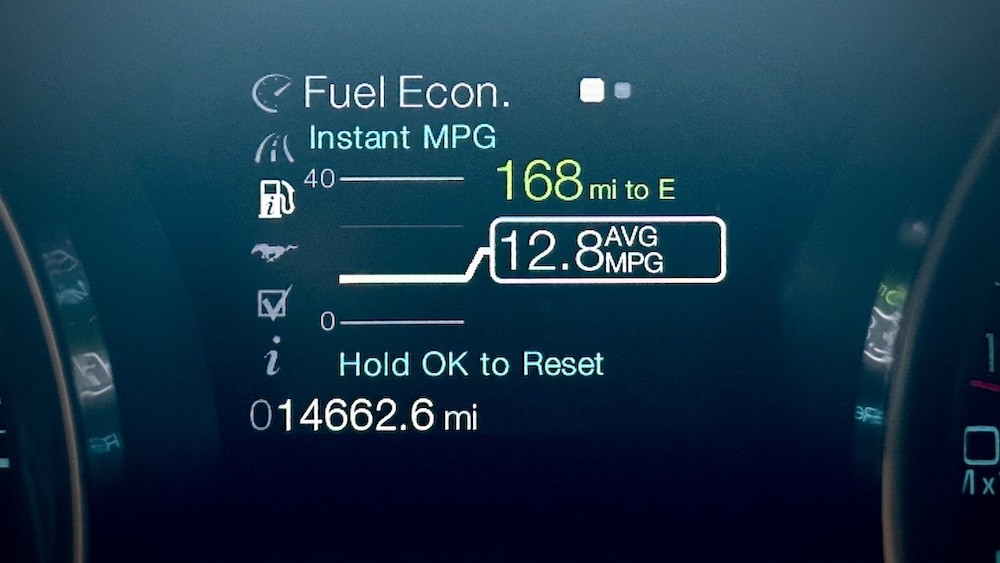 Fuel economy display from a 2013 Ford Mustang Boss 302 showing city driving MPG
Fuel economy display from a 2013 Ford Mustang Boss 302 showing city driving MPG
In this context, the 5.0L Coyote V8 is far from a gas guzzler. It represents a remarkable achievement in engine technology, offering substantial power gains and enhanced refinement while maintaining reasonable fuel consumption. While not as frugal as a hybrid, the Coyote strikes a balance between performance and efficiency that appeals to many truck owners.
Factors Influencing 5.0L Coyote Fuel Economy:
- Tremor Trim: Our test vehicle was an F-150 Tremor, an off-road-focused model with shorter 3.73:1 rear gearing and larger, heavier tires. These factors inherently reduce fuel economy compared to standard F-150 models.
- Driving Style: Aggressive driving, frequent hard acceleration, and high speeds will significantly decrease fuel economy. Our test included some spirited driving, which likely impacted the overall MPG.
- City Traffic: Stop-and-go traffic, idling, and low average speeds are the biggest enemies of fuel economy for any gasoline engine. Los Angeles, with its dense traffic, represents a particularly challenging environment.
Final Verdict: The Ford F-150 5.0L is No Gas Guzzler, But Consider Your Priorities
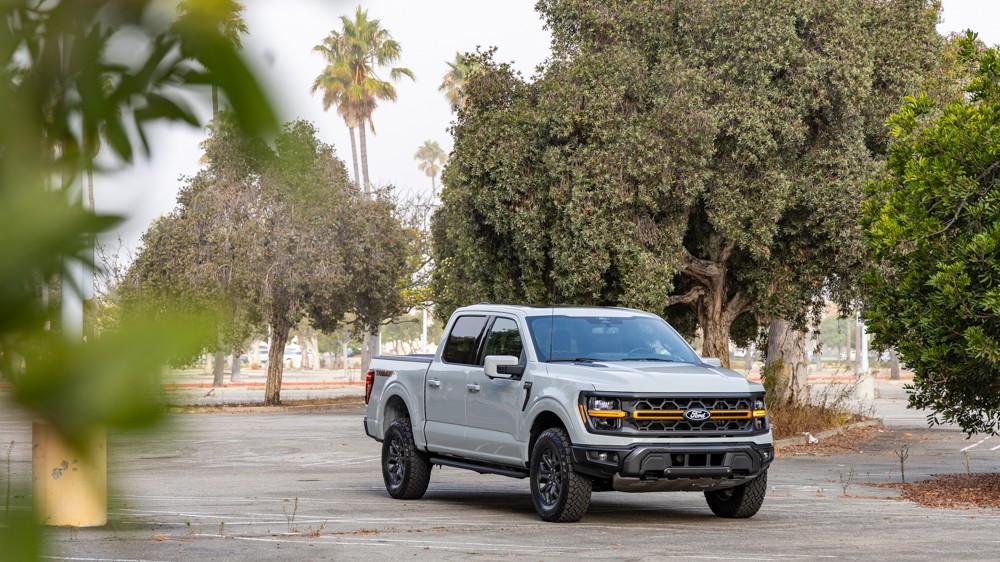 2024 Ford F-150 Tremor in an urban setting, emphasizing its 5.0L Coyote V8 power
2024 Ford F-150 Tremor in an urban setting, emphasizing its 5.0L Coyote V8 power
Our week with the Ford F-150 Tremor and its 5.0L Coyote V8 in city commuting reveals a nuanced picture. Is it the most fuel-efficient option in the F-150 lineup? No, the PowerBoost hybrid clearly takes that crown. However, is the 5.0L Coyote a gas guzzler in modern terms? Based on our real-world testing, and considering its power output and vehicle size, the answer is also no.
The Ford F-150 5.0L Coyote V8 delivers respectable city fuel economy for a naturally aspirated V8 in a full-size truck, especially when compared to older V8 engines. If maximizing fuel economy is your top priority, the PowerBoost hybrid or EcoBoost engines are likely better choices. But if you value the classic V8 experience, the robust power, and the signature sound of a naturally aspirated engine, the 5.0L Coyote remains a compelling option that won’t completely break the bank at the gas pump, even in city driving. For those spending more time on highways or in less congested areas, you can expect to see even better fuel economy figures from the Ford F-150 5.0L V8.
